
Slavic Union is on the rise in Eastern Europe
Media attention for the Alt-Right and related identitarian groups often focuses on the spread of phenomena in the West: Trump in the United States, Brexit in the UK, AFD in Germany, FPÖ in Austria, Wilders and Forum voor Democratie in the Netherlands. A development that is not discussed in many is the growth of the ideas of the common-Slavic nationalist wave, of which the Slavic Union is a case in point.
This article deals with the rise of New Right nationalism in Eastern Europe and the idea of the Slavic Union - the utopian space of Slavic nation that would leave the West in fear. Focusing on the movement's discourse, I will review the movement's fundamental ideas and how these are broadcasted on social media.
Many of these ideas resemble the tradition of Anti-Enlightenment that is also prominently articulated in the West by New Right movements and politicians. Slavic Union also stressing the differences between "us", as an ethno-cultural nation, and “them”, framed as a threat from the outside, notably from migrants and the West. And just like the Western actors, Slavic Union aims to build a new world, a world of nations. "Its power of attraction lay in its appeal to all that divides men– history, culture, language – as against that which unites them: their condition as rational individuals with natural rights" (Sternhell, 2018).
They use social media less as ‘social’ and more as ‘media’.
Using digital ethnography, I analyze the core ideas of the radical groups and their origin as well as how they are spread on the internet - on Vk, Facebook, YouTube, and other open sources. All the data comes from public sources. I focus on analyzing profiles, pages, website, and contents from Slavic Union activists and movements that were open for all, such as on Vk public groups, YouTube videos, and Wikipedia pages to collect more information about the distribution and the ideas of the radical Pan-Slavic groups. Most of the online communities start on Vk, the so-called ‘Russian Facebook’. Since the activity of Slavic Union-related organizations is neither approved nor banned in the country, they use social media less as ‘social’ and more as ‘media’. And even if the Slavic Union is no longer active as a party now, its influence is still palpable.
What is Slavic Union?
At the core of Slavic Union stands Pan-Slavism - the ideology of unity and unification of all the Slavic or Slavic-speaking nations. The goal of Pan-Slavic movements is to group 250-300 million people and have half of Eurasia connected by the common ideas, which would make the Pan-Slavic zone into the biggest union of the world.
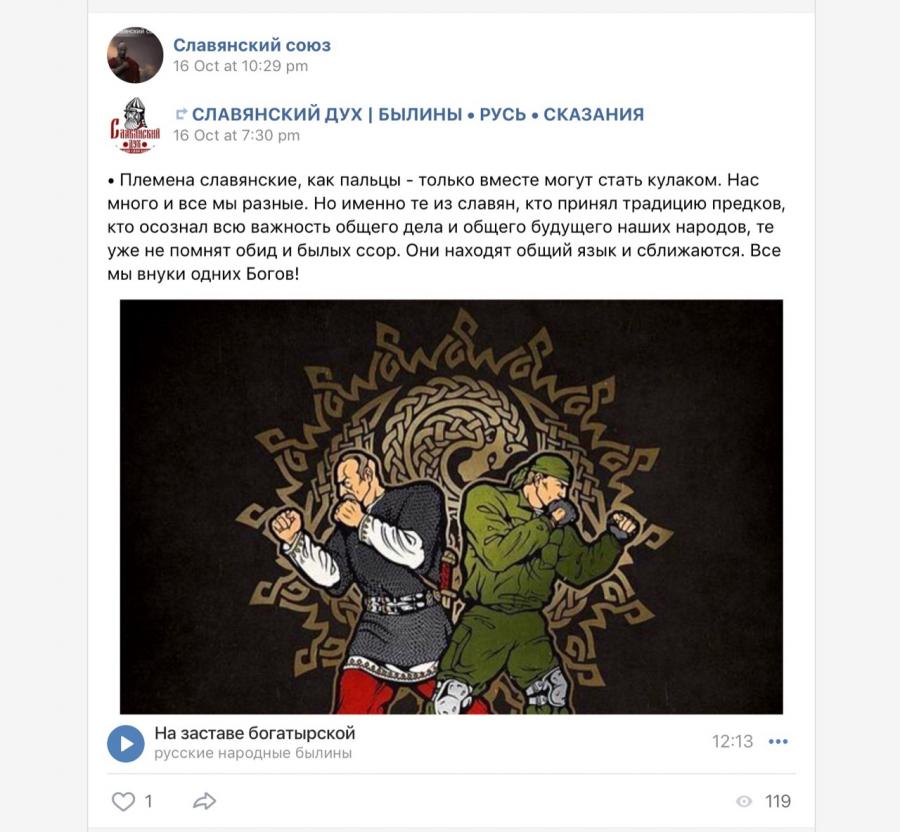
Post on VK explaining that slavic folks are like fingers- only strong in a fist/ when united. Merging traditional and modern images; 119 views and 1 interaction
The growth of right-wing groups in some Eastern European countries became visible after the fall of the Soviet Union and many of the new movements started in Moscow. They targeted the growing numbers of foreign migrant workers choosing Moscow as their destination. Around the year 2000, Russia appeared on the second place among the countries with the highest influx of international migrants.
These right-wing groups were never officially supported by the government. On the contrary, one of the biggest parties, 'Slavic Union' (Славянский Союз), was banned in 2010 for its extremist activity. The fact that it was founded in 1999 can be linked to the high immigration rate in the years after the end of the Soviet Union. And we can see that these radical ideas were emerging and spreading throughout Russian society, even though they were never really acknowledged by the powers-that-be.
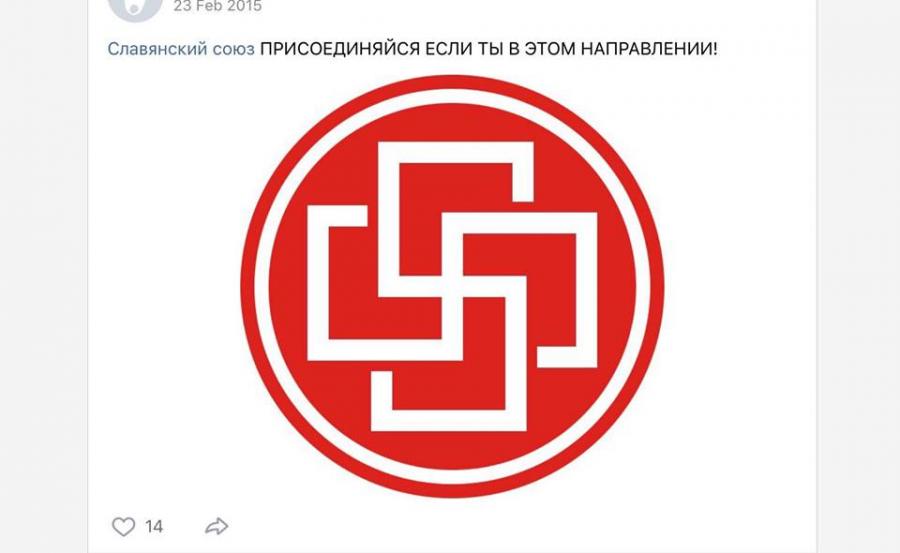
"Slavic Union (hyperlink) join us if you are moving in the same direction!" and the symbol of Slavic Union which consists of two stylized S in a form of swastika
Slavic Union, with its core in Pan-Slavism, aims to create a greater single nation-state. The name of the organization is quite explicit and meaningful in itself. Slavic Union, or Славянский Союз in Russian, when abbreviated, sounds as “CC” in Cyrillic or SS in the Latin alphabet, which can be read as a reference to the Schutzstaffel, the former military and paramilitary elites of Hitler's Germany. The Slavic Union’s ideology could be summarized as “Neo-Nazism, Pan-Slavism, White supremacy, Nativism, Anti-immigration Anti-communism, Antisemitism, and Homophobism”.
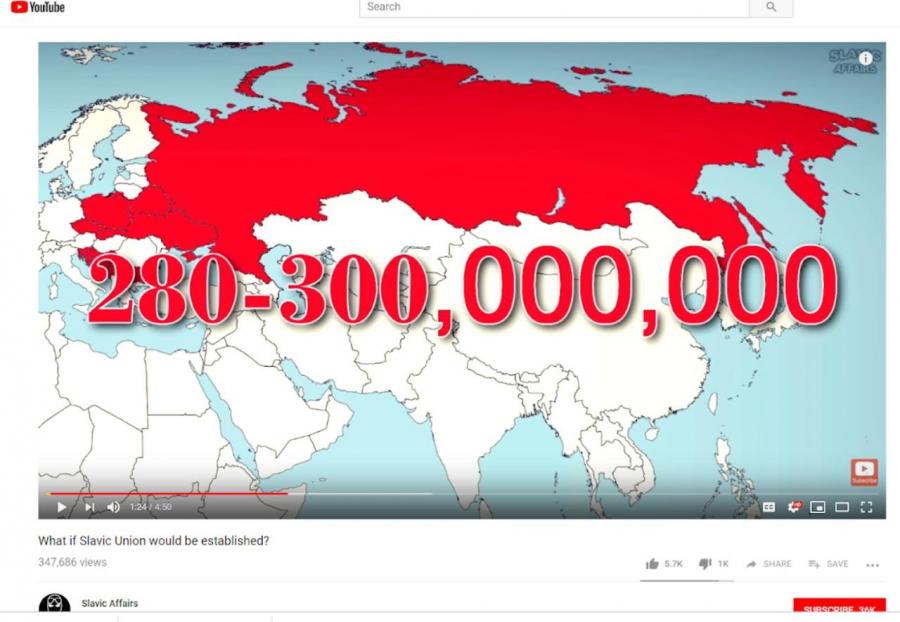
The Slavia visualization
The rise of Slavia on Social Media
Even though "most research on the revival of nationalism, radical right and extreme right parties and movements avoids the impact of digitalization" (Maly, 2018), social media are at the core of the distribution of New Right ideas. The analogy with the Swedish Metapedia could be established in relation to the New Right Slavic groups. "The most interesting thing about the Swedish website Metapedia – a fascist equivalent of Wikipedia – is not that it has a positive view of Adolf Hitler, which must be considered commonplace for a website of this kind. Rather, the significant characteristic of Metapedia is that it is truly international" (Arnstad, 2015).
Slavic Union was connected to other organizations in a net network structure, as can be judged on the basis of open sources and Wikipedia. This network did not operate exclusively in the public sphere of Russia, but went far beyond its borders.
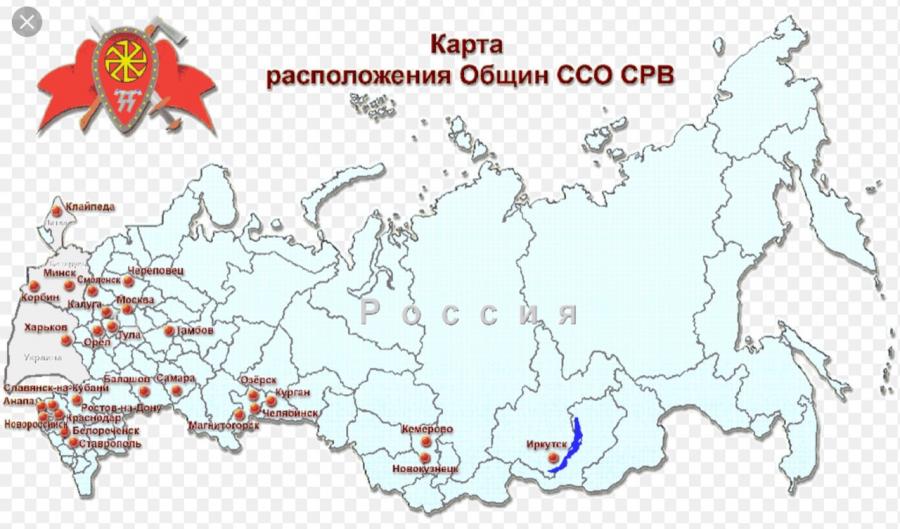
The spread of the Slavic Union party
The communities connected by the Pan-Slavic common ideas resided in Russia, Belarus, and other Eastern European countries such as Bulgaria, Ukraine, Macedonia, Poland, Serbia, and Czech Republic. In addition, these ideas attracted people from other countries with Slavic origins or fans of the Slavia concept. These ideas are mostly spread through social media and have an international reach. These ideas are spread in different languages and with a focus on multiple countries for accessibility and growth.
We do not see many interactions in the form of reposts, likes, or comments, but we see a disproportionately large amount of views.
These loosely connected groups are a case of networked social movements (Castells, 2013). These networks function as media networks serving a metapolitical goal: they are used to introduce ideas and let them circulate. When we look at some of the posts, we do not see many interactions in the form of reposts, likes, or comments. However, we see a disproportionately large amount of views. This can be explained by the use of social media as information platform and news distributor in a context where the government is probably watching. "Since mainstream media, including encyclopaedias, are considered to be infested with lies, there is a need, ... for an alternative..." (Arnstad, 2015). New media are here used to spread information and introduce new people to the basic ideas of the movement; state repression ensures that such people are careful in showing overt support.
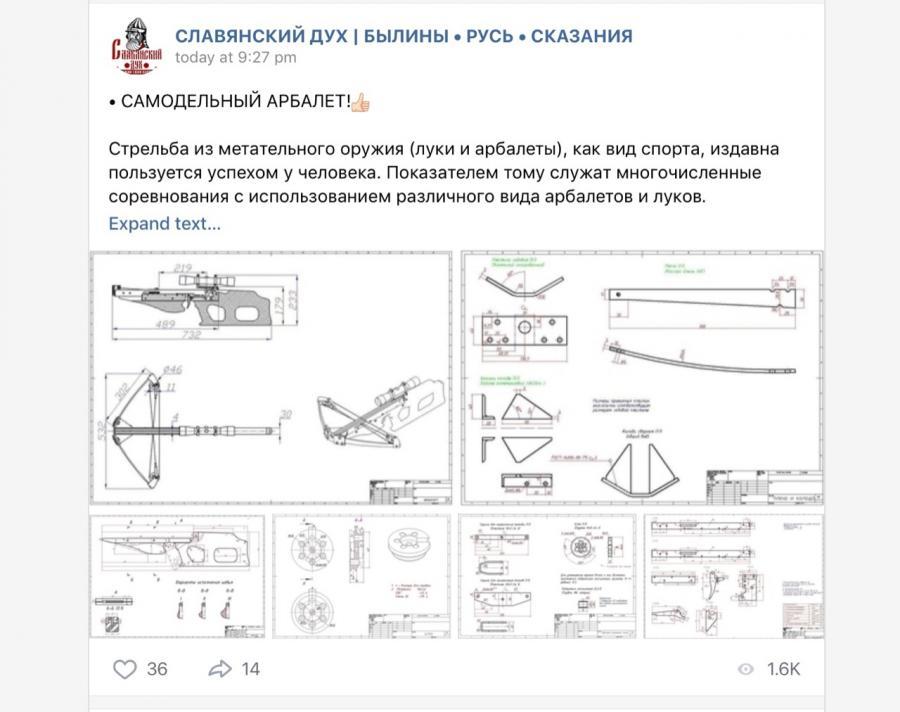
Homemade weapons tutorial, presented as ancient sport of slavs; 1,6K views and 36 likes/ 14 shares
The promotion of ideas and concepts takes place in publicly available groups on Vk. Through reposts they are spread to other related groups, they interlink, merge, and expand the scale of circulation of such radical ideas. From seemingly anodyne posts containing information about traditional Slavic mythology, they lead to information on homemade weapons and pictures from the war zones.
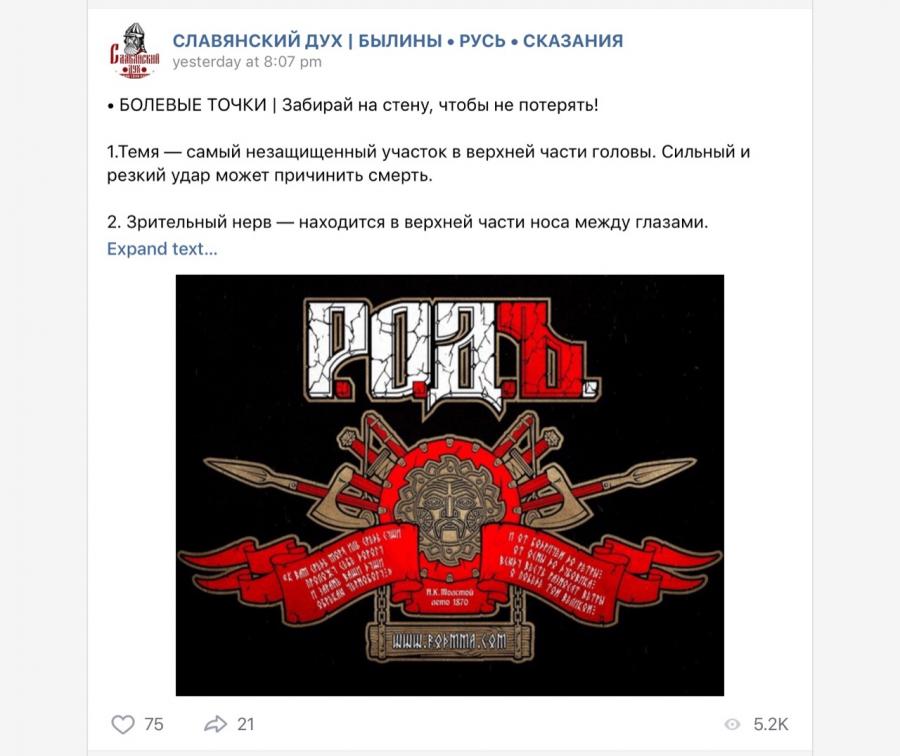
Post on Vk group which explains the pain points on human's body styled with runes and slavic pagan symbols
Similar groups operate on Facebook as well, though they are smaller in number and less dense in terms of connections and layering of information. They often post in English or in Slavic languages with an English translation. Different platforms thus target different kinds of audiences. While groups on Vk are more focused on encouragement, mobilization, and information, Facebook posts display a more entertaining nature. However, alongside relatively innocent memes, there can occasionally be found appeals to a more liberal gun control or posts about the importance of blood purity, as illustrated in the images below. Interactions on Facebook are much higher than on Vk too, as Facebook is perceived as a medium less controlled by public authorities.
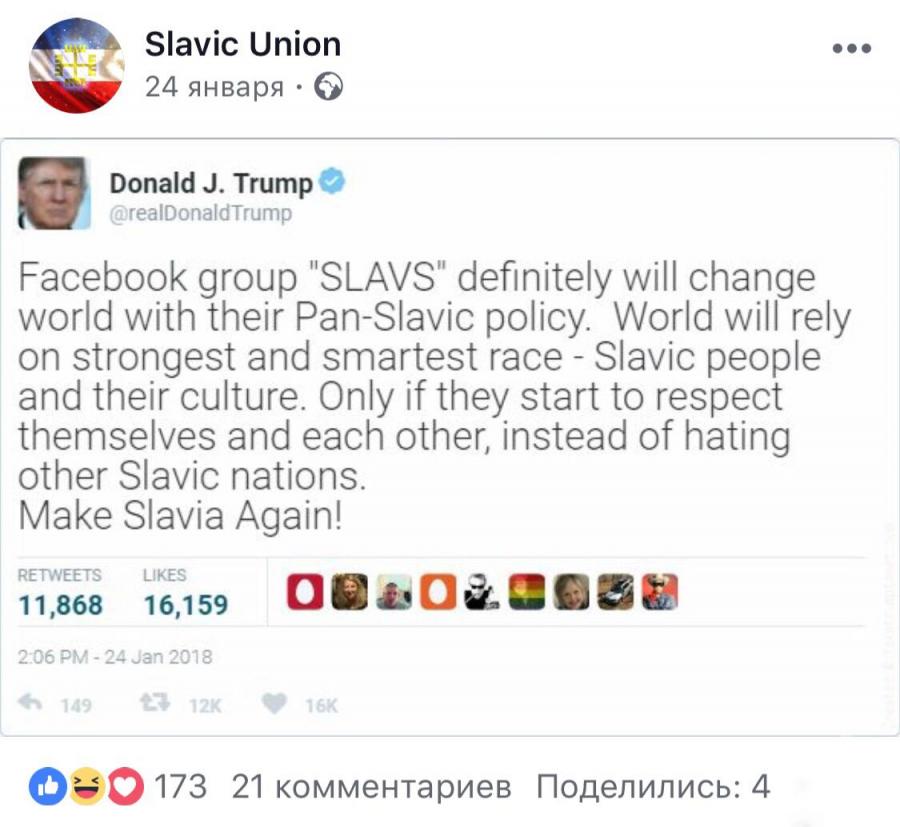
Entertaining content with radical subtext

Claims for the gun law among the relaxed content
YouTube content on the topic of Slavic Union also differs when we compare videos in English with videos in Russian. The former have a rather informative character, explaining the numbers and the aims of Pan-Slavism and the Slavia concept (see image below). In Russian videos, however, we observe military engagement as well as personal testimonials and appeals for joining the forces to fight for the nation.
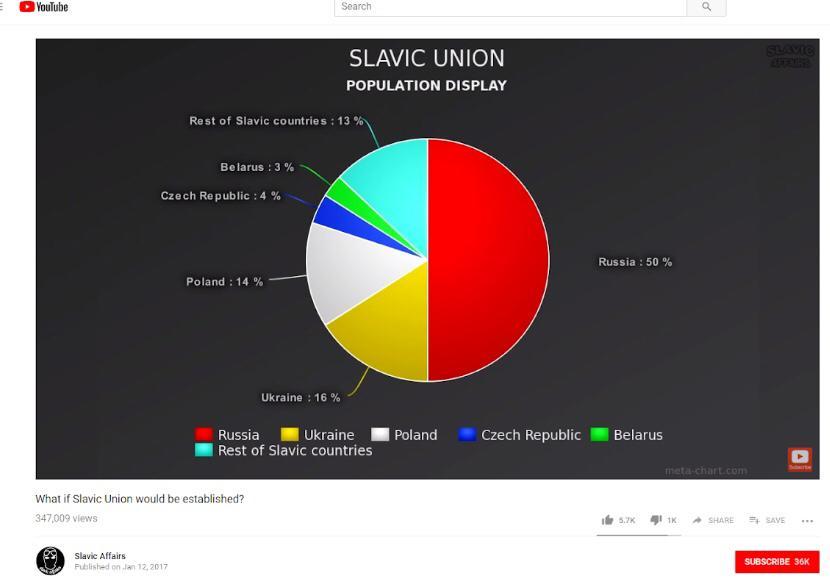
Informative character of YouTube videos of Slavic Union in English. It gives the statistics, as well as explains the concept in detail
Historical links of the Slavic Union ideology
Let us now look deeper into the ideology of Slavic Union. This ideology is a clear manifestation of what Zeev Sternhell calls the anti-Enlightenment tradition. The anti-Enlightenment tradition puts the organic nation at the core and perceives “democracy and pleas for equality…[as] an attack on the natural order.” (Maly, 2018). Slavic Union, with at its core its Pan-Slavism, aims at creating a greater single nation-state. The Slavic Union's views constantly refer to a centuries-long history. Rising migration was just a trigger for the visibility of anti-Enlightenment ideas in Eastern Europe.
In their rhetoric, Pan-Slavic groups frequently refer to this historical context. They use links to the ‘good old times’ when Slavic countries were still united in one great superpower that held all the neighboring nations in fear. The main focus in such historical references are the Soviet Union and Kyivan Rus. Pagan tribes are mentioned as evidence of a long and powerful history. This creates a revisionist idea of that past, as can be seen in the picture below where semiotics of classical Soviet Propaganda are blended with tribal semiotics. The communist hammer and sickle have been replaced by a tribal sign.
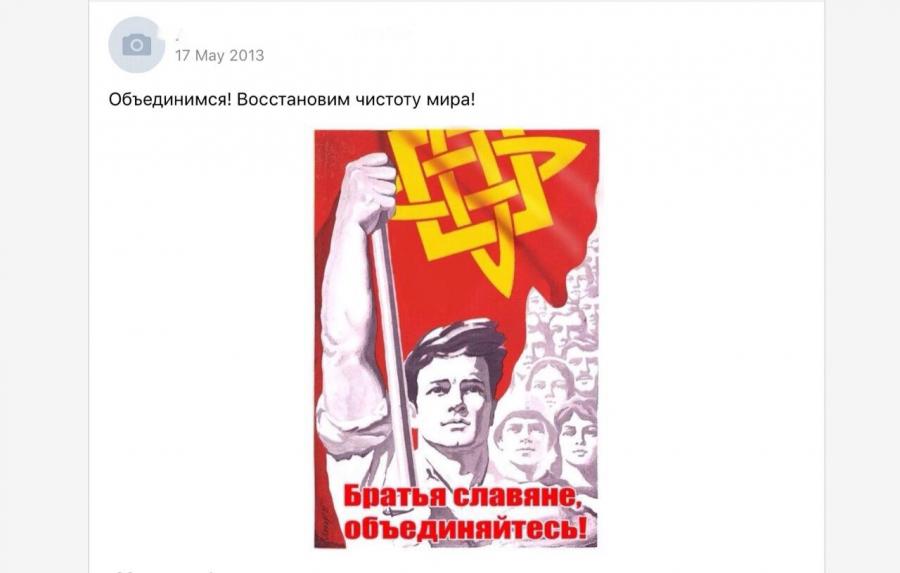
Soviet Union propaganda art styled with "Brother slavs unite!"
The use of historical context in the rhetoric of the New Right is very selective and fragmented. It mostly consists of a bricolage of bits and pieces of time frames (some of which might, in fact, not be that beneficial to some of the Slavs) proclaiming the greatness and the power of the Slavic "race" as a whole.
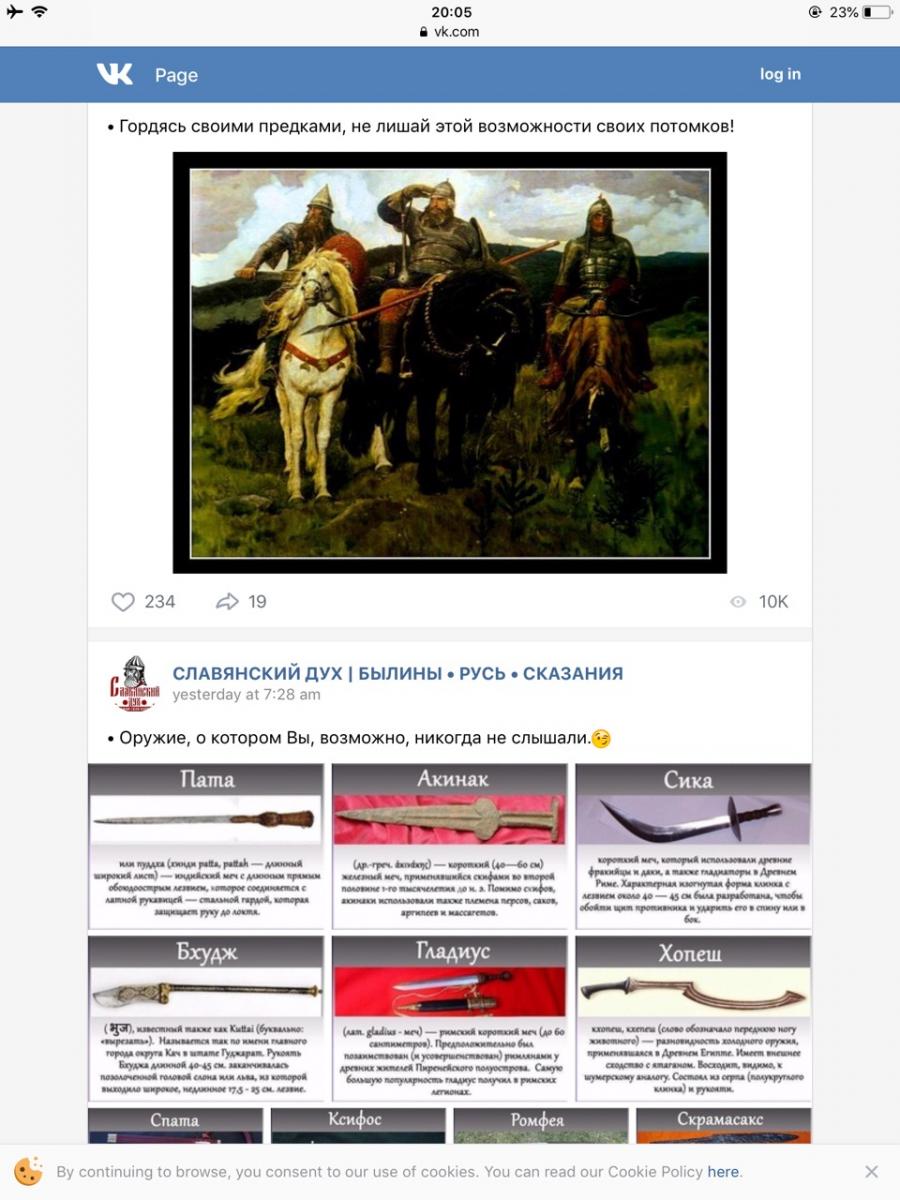
The upper post shows Three Bogatyrs, traditional characters from medieval East Slavic legends of the ancient Kyivan Rus, the caption says "Being proud of your ancestors do not do not deprive your kids from this opportunity". Below rare weapons are shown
Enemies and examples
As presented in these online groups, two actors are blamed for the decline of the Slavic countries. The first one is the West, an external factor presented as a perennial threat. The second enemy is internal: refugees and foreign migrant workers. The role of the common enemy - and old political technique - is crucial as a motive for unification: "...we have this consolation with us that the more complex the conflict, the more glorious is the triumph" (Paine, 1776/ 1953).
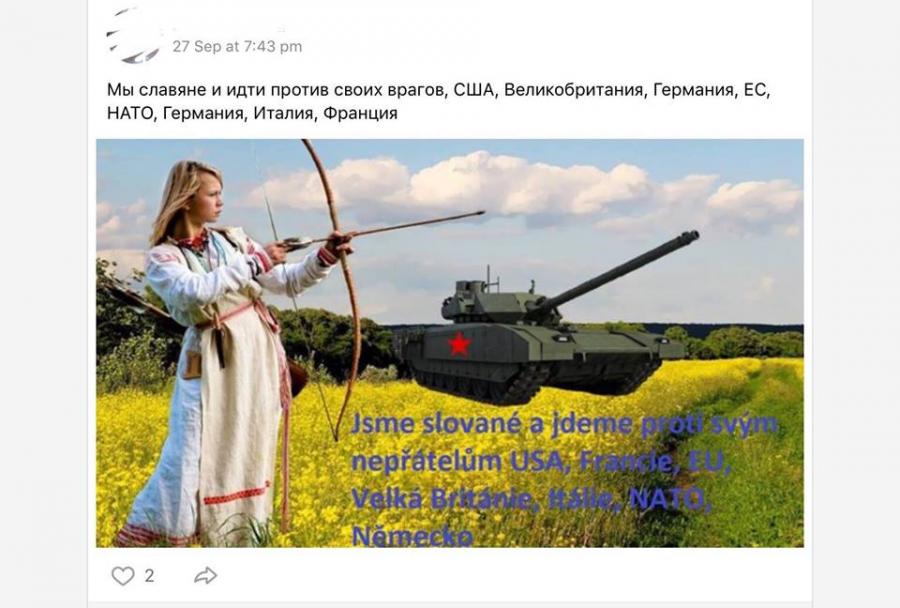
"We are Slavs and we go against our enemies USA, France, EU, Great Britain, Italy, NATO, Germany", merging of the ancient pagan and of the Soviet, text in Czech with Russian translation
Contemporary Belarus is often represented on Vk as a perfect country. Its location geographically connects Russia with other Slavic countries. Most of the population there speaks and understands Russian along with Belarusian. With Lukashenko as a stable leader, a unified nation and a favorable visa regime with the EU, it remains a mono-national country with a relatively low influx of migrant workers. According to Pan-Slavic groups on Vk, this is the ideal all Slavic nations should look forward to.
Religious ties
Pan-Slavic groups such as Slavic Union often promote spiritual development and religion on their social media platforms. Two main directions are to be noticed. The first one, more prominently discussed on Vk than on Facebook, is the unquestionable authority of Christian Orthodoxy. This allows for a distinction between Slavs and Western Europeans, who are predominantly Catholic or Protestant.
As said, this religious motive is less prominent on Facebook, probably because of the high number of non-Orthodox Slavic users, who might feel excluded. Religion is the defining feature that helps building gaps of cultural differences and highlighting the contrast between Slavic identity and the outside world.
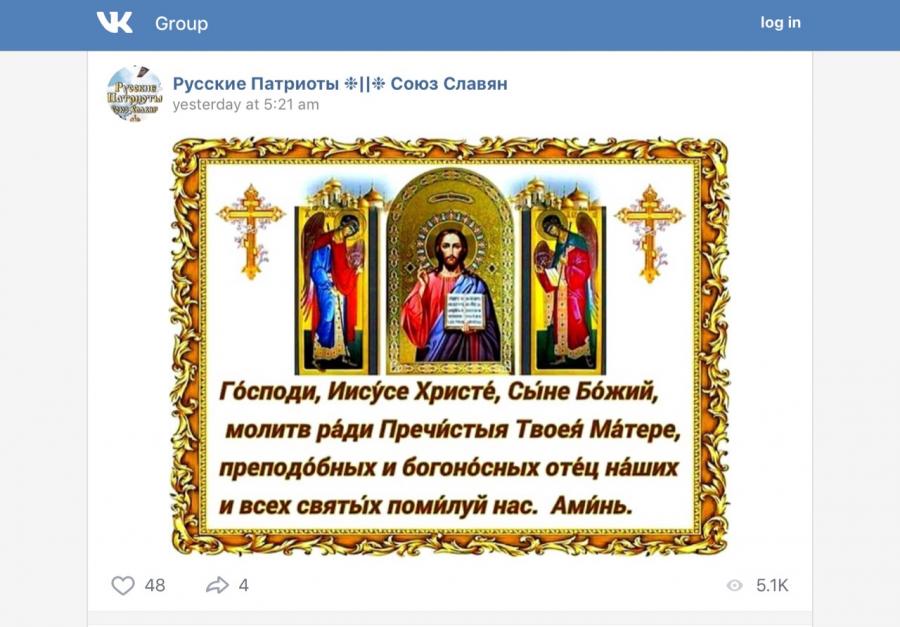
Images of Orthodoxy on the Vk group. 5 100 views and 48 likes, 4 shares
The second spiritual context that is used focuses on pagan beliefs. Mentioning ancient legends and mythology serves as a marker for self-sufficient identity and recognition that ‘we were there even before Christianity’ and supports claims to unity and authoritative history. Runes are also used quite often, as well as rune-styled Slavic words.
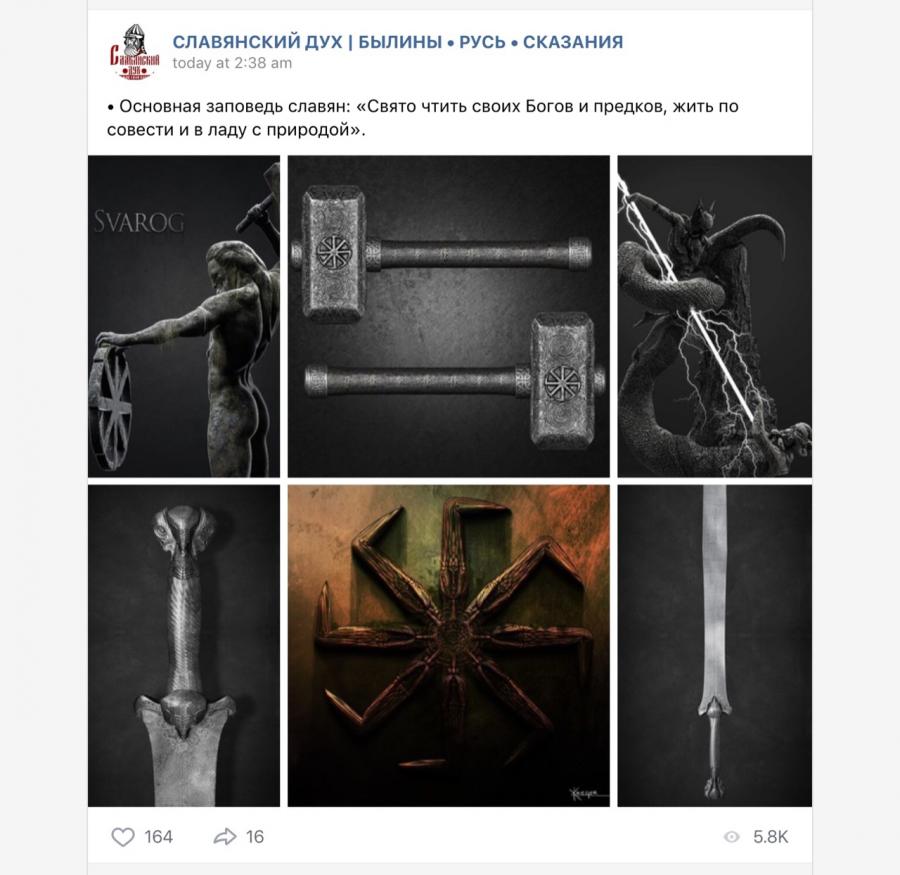
Reference to pagan slavic believes, such as to Svarog on the first image. The description says : "The main commandment of slavs is piously honor their gods and ancestors and live according to conscience and in harmony with nature".
The two religious contexts clash and dominate to a different extent on various online groups. Orthodox Christianity gives the groups a clear focus of identity in a contemporary context, while the pagan cults introduce 'ancient' and supposedly Pan-Slavic symbols such as the reversed swastikas, framing these as deep-cultural and thus acceptable features.
The picture below states: "The Orthodox War for ... Russia ... Conducts regular recruits and poisoning of volunteers ... on the former territories of Ukraine. We'll equip, train, and send you. The recruitment is carried out for men older than 23 ... To enroll in volunteers, you must send a friend request ... or contact the administrators of the group ... Material assistance card number ... We will win, God be with us, glory to Russia."
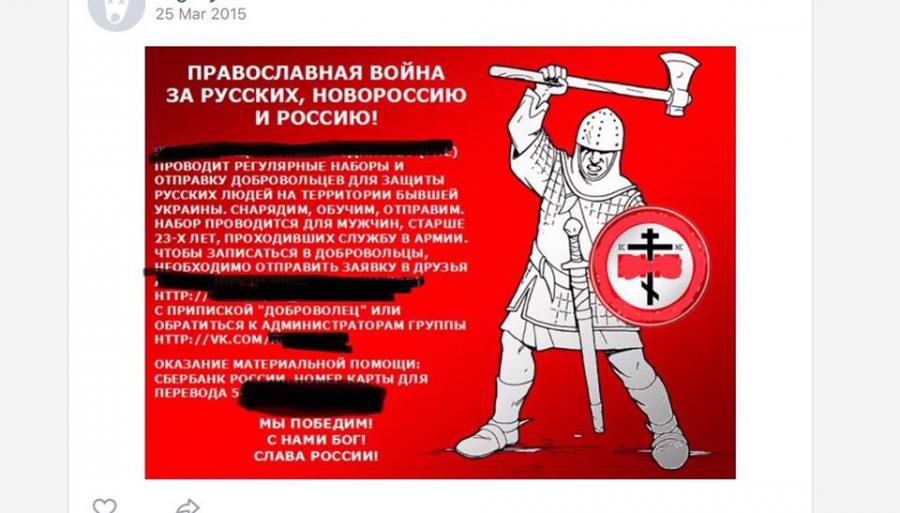
The recruitment of members, which is posted along with the more neutral content
The purity of the Slavic body
Slavic identity as discussed in this online discourse has a few key markers. A true Slavic person has to live or have their roots in an Eastern European country and has to be dedicated to the Slavic nation. Based on these two fundamental characteristics, more features enter the picture.
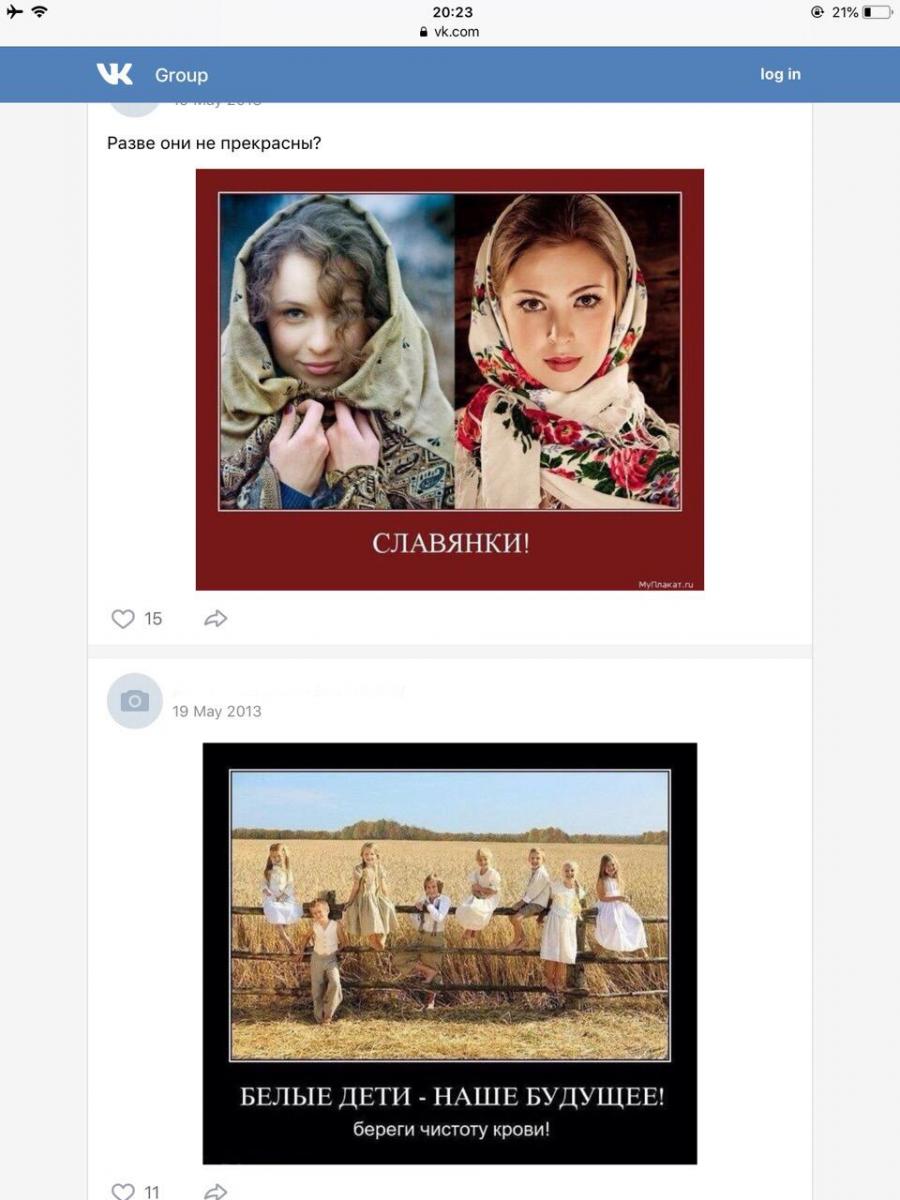
Glorifying of slavic women in the first post and proclaiming "While kids are our future! Protect the purity of blood" in the second post
Physical features and appearance are crucial: the Slavic person has to look "Slavic". Women, ideally, display beauty and innocence expressed by blond hair and blue eyes. Similar principles go for men, who have to look 'masculine' and physically strong in body and in manners. Interracial relationships are strongly discouraged, because they provoke impurity of Slavic blood, while marriages among Slavs are strongly encouraged as beneficial and healthy.
Social media are crucial because most groups do not have an official status and internet is a cheap, fast, and effective way to convey a message.
The discourse of a healthy body - “my body is my temple” - is actively promoted on social media. Alcohol and drug abuse are strictly forbidden because they ruin the Slavic genes and cause health and fertility problems. In line with the Anti-Enlightenment tradition, the differences between men and women are emphasized and highlighted, and their roles are strictly defined. By promoting a healthy lifestyle, the goal is to keep one's body strong so as to be always ready to fight (for men) or give birth (for women). Even tattoos are perceived as something unworthy, unless the tattoos show the Pan-Slavic pagan symbols.
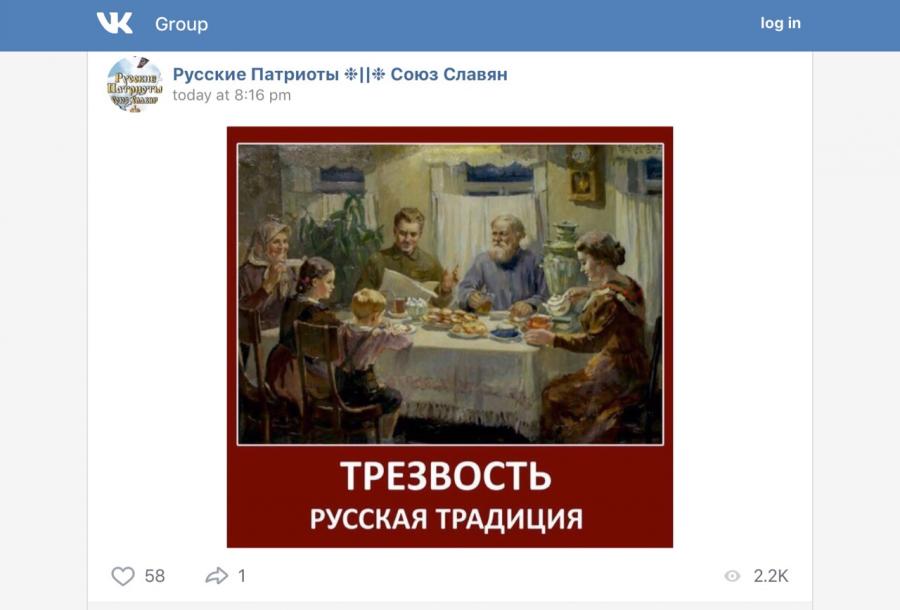
"Sobriety is an ancient Russian tradition"
Numerous YouTube videos feature men articulating this kind of masculinity discourse. They show their muscles and fighting skills and have an appeal of 'toughness'. Many raise the topic of defending the nation. In the screenshot below, we can see a prominent example of Slavia-related YouTube content in Russian. In the video, the man talks about the need to defend the nation against migrants and to safeguard Slavic blood purity. As we can see, in this context "nationalism is thus (1) solely imagined within the territory of the nation-state and (2) cultural globalization is completely absent in his analysis" (Maly, 2018). The man highlights the importance of a healthy lifestyle and declares his rejection of drugs and alcohol. After his speech, footage of fighting follows.
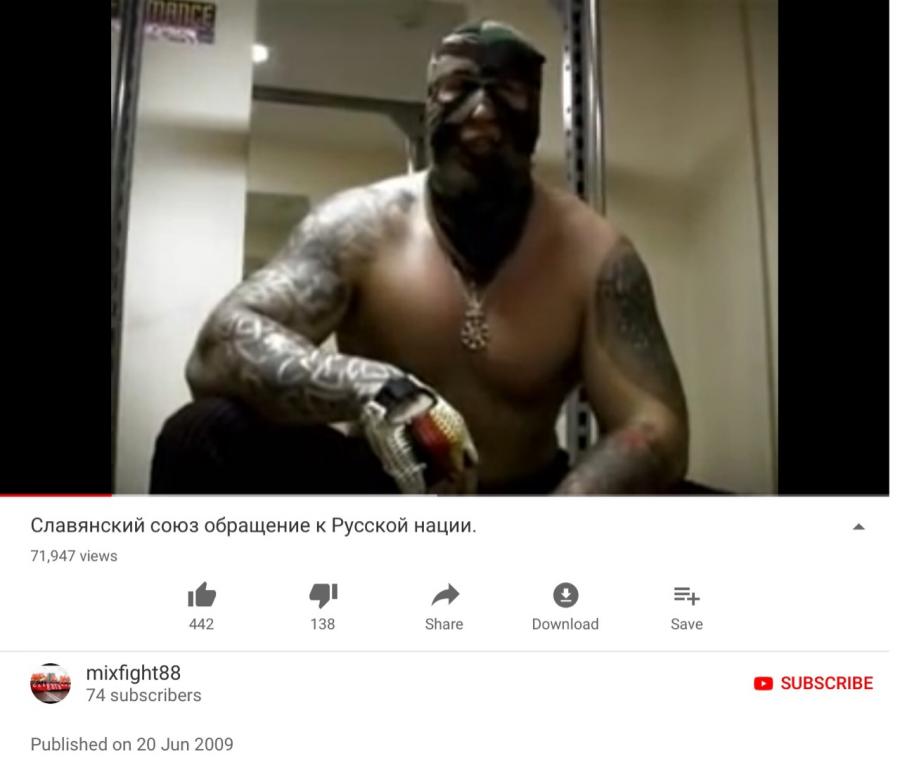
Prominent is that the video is uploaded by "mixfight88", the references are both to the 'masculine' discourse and to the white supremacy symbols. The video has almost 72 000 views
Sports exercises and an active, sober lifestyle are promoted as mandatory for the development of body, spirit, and character. Sometimes these recommendations are broadcasted into the offline world. "Social movements, throughout history, are the producers of new values and goals around which the institutions of society are transformed to represent these values by creating new norms to organize social life. Social movements exercise counterpower ..." (Castells, 2015). Young people are invited to gather in so-called ‘sober’ meetings, where they practice physical endurance and martial arts techniques. This is also one of the ways in which new members are being scouted.
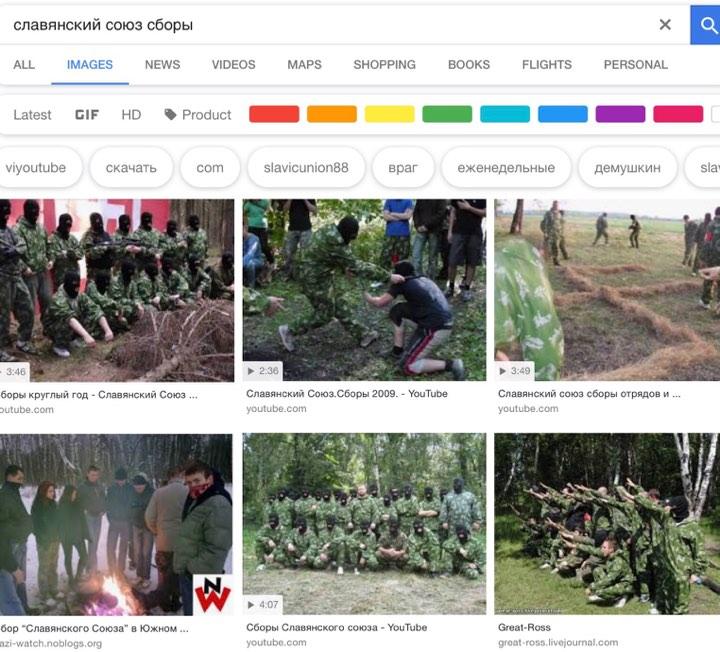
"Slavic Union gatherings" on Google search
The Pan-Slavic New Right in action
Since "in recent decades the nation and nationalism became transnational phenomena" (Maly, 2018), we can see many New Right groups emerging all around the world. Reflecting the ideas of Anti-Enlightenment, they use social media affordances and algorithmic activism to spread their message to audiences worldwide with the aim to build a different reality.
The connectedness of the groups in forms of reposts and their international reach both help the movement to be effective online. In the 21st century, 'collective action is never completely spontaneous given that pure spontaneity does not exist'. (Gerbaudo,2012) The internet contributes to this phenomenon. By looking at Slavic Union-themed groups, we can see the operational pattern and distribution of Alt-Right ideas in Eastern Europe. They create networked social movements that use "...internet as key infrastructure, as a fundament and the birthplace..." (Maly, 2018).
Social media are crucial in this, because most groups do not have an official status and the internet is a cheap, fast, and effective way to convey the message. Those who use such platforms inform their audiences on the topical news and gatherings of the movements. At first glance, such online activism starts off as a seemingly leaderless activity, but as shown in the case discussed here, it is carefully planned and never spontaneous. Social media help not just to spread the Pan-Slavic message, but to recruit new people to the online and offline activities of the communities. In that sense, Pan-Slavic groups are fully in line with other, better documented New Right groups, and they deserve more attention in research.
References
Arnstad, H. (2015). Ikea Fascism: Metapedia and the Internationalization of Swedish Generic Fascism.
Castells, M. (2013). Communication Power.
Castells, M. (2015). Networks of Outrage and Hope: Social Movements in the Internet Age.
Gerbaudo, P. (2012). Tweets and the Streets: Social Media and Contemporary Activism.
Maly, I. (2018). The New Right, global nationalistic activism and the Flemish identitarian movement Schild & Vrienden. A case study. Working paper.
Maly, I. (2018). Anti- Enlightenment Tradition. [PowerPoint Slides].
Maly, I. (2018). Discourse analysis. [PowerPoint Slides].
Maly, I. (2018). Hard boven hard. [PowerPoint Slides].
Paine, T. (1953). Common sense and other political writings. The Bobbs- Merril company, Inc.
Sternhell, Z. (2008). How to Think about Fascism and its Ideology.
United Nations. (2017). International Migration Report 2017.